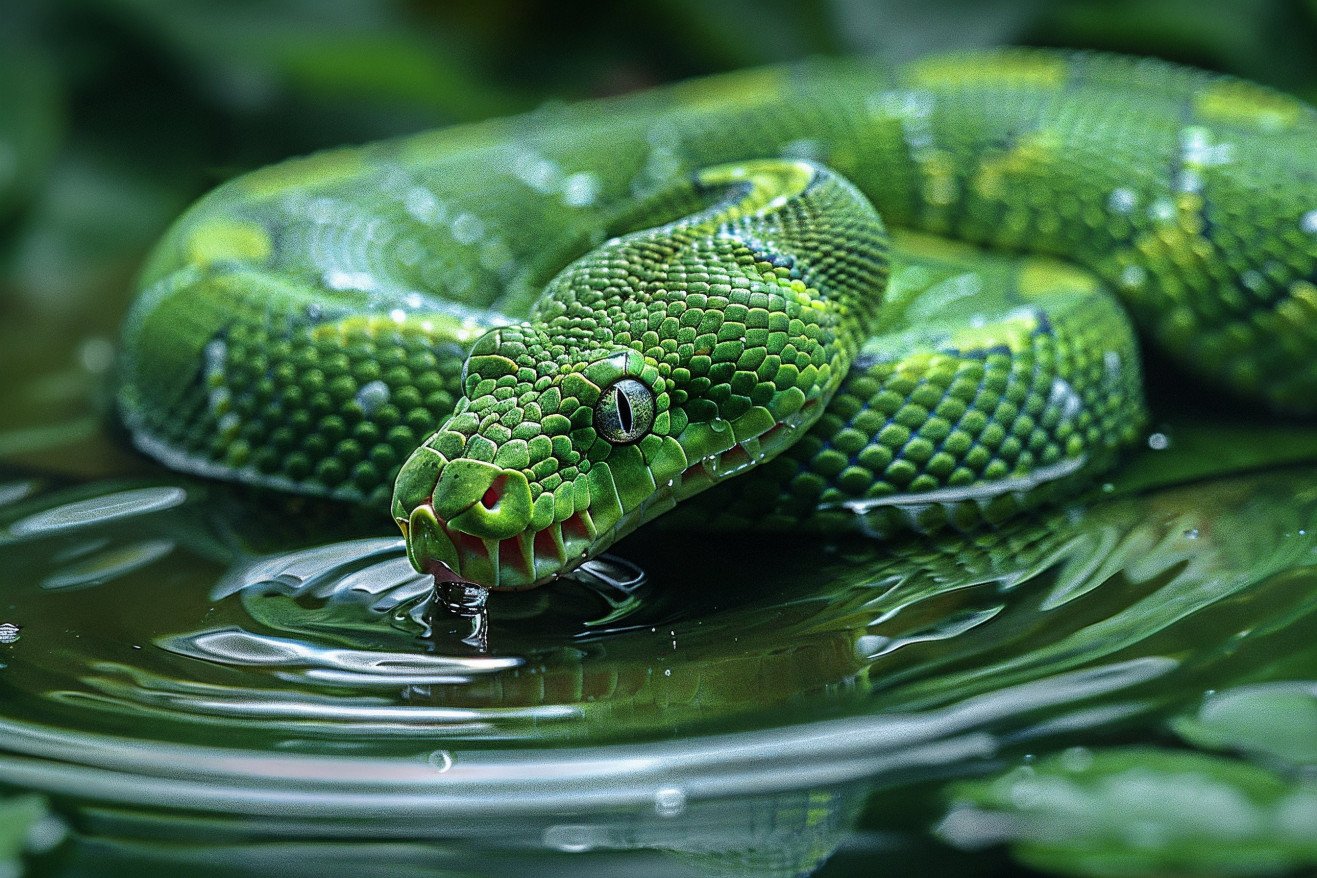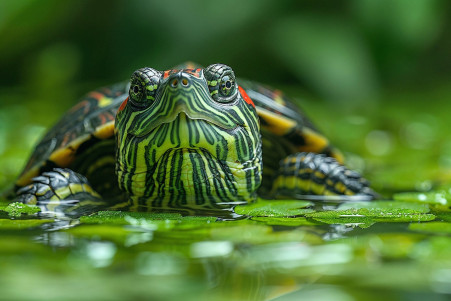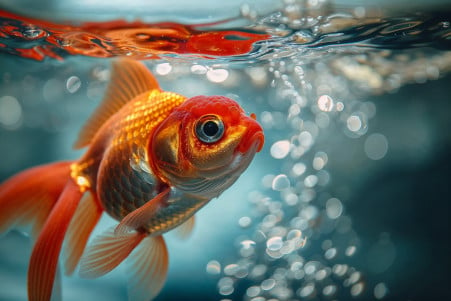How Do Snakes Drink Water? The Mystery of Their Hydration
23 February 2024 • Updated 22 February 2024

Snakes are mysterious creatures in many ways, but how does that mystery extend to their drinking habits? Snakes do drink water, but they do so in a way that is unlike any other animal. Snakes’ lower jaws have evolved to act like a sponge, allowing them to absorb water, which is then moved to the stomach via the muscles.
However, it’s a myth that snakes can absorb water through their skin and that they have specialized scales that help them do so.
In this article, we’ll satisfy your curiosity by looking at some of the most interesting zoological and scientific research that explains how snakes get the water they need. From the biomechanics of how they drink to the physiological changes that help them conserve water, we’ll take a deep dive into the complex relationship between snakes and the substance that is essential to all life.
We’ll also look at a combination of biological and environmental factors that show just how important water is to snakes.
How do snakes drink water?
The Sponge-Like Secret of Snakes’ Drinking
Snakes have developed a unique way to drink water. It was first described in a landmark paper in the Journal of Experimental Zoology Part A in 2012, and according to Treehugger, it was the first time that scientists had ever seen this sponge-like tissue in the lower jaw of snakes.
This complex structure is not a random occurrence; it is formed by folds of soft tissue that act like capillary tubes, drawing water up when they are not stretched out to accommodate the snake’s swallowing.
The process is complicated but effective. When the snake’s head muscles and bones contract and expand, they work like a sponge to pull water in and then move it down to the stomach. This is very different from the buccal-pump model, which was the previously accepted way that snakes drank water. This model required the snake to have a closed mouth to create the suction needed to drink, according to Discover Wildlife.
This sponge-like drinking mechanism was confirmed in a study that used synchronized video and electromyographic recordings of muscle activity in the cottonmouth and the Eastern hognose snake, according to PubMed. Not only does this research disprove the old model, but it also shows how snakes have evolved to adapt to their environment.
Slaking Thirst: The Amazing Adaptation of Snakes’ Skin Drinking
In the dry, desolate regions of their natural habitats, snakes have the amazing ability to absorb water through their skin, which is extremely important since water is often hard to come by.
According to Reptile Knowledge, the ability to absorb water through the skin, also known as cutaneous water absorption, is more than just a backup plan, it’s a critical adaptation for these animals. Their skin’s scales are like tiny reservoirs, collecting and directing water to the cells that need it most.
Dehydration in snakes can be subtle, like skin that appears wrinkled, to extreme, where the snake’s body systems start to shut down, which can be life-threatening, showing just how important it is for snakes to stay hydrated. This is especially true for snakes that live in desert environments, where cutaneous water absorption is often the only way they can get the water they need since there are no other water sources available.
While many people think snakes use their tongues to drink, in reality, they’re using them for olfactory purposes, as described by Reptile Knowledge.
The ways snakes actually drink are much more complex and show the impact of millions of years of evolution in harsh, dry environments. The ability to absorb water through their skin is evidence of snakes’ ability to adjust to their surroundings, even when that involves drawing essential water from the air and the moisture that accumulates on their skin when there are no other sources available.
How Snakes Drink Water
Snakes have evolved a number of anatomical adaptations that allow them to control water intake and minimize water loss, which is important for their survival in a range of environments.
Research articles listed on PubMed have demonstrated the interaction between the snake’s muscular and skeletal systems that allows them to drink through their sponge-like tissue and conserve water. This study found that muscles that are typically used for feeding are repurposed for drinking, which is a highly evolved response to their environment.
Meanwhile, a study in the Journal of Experimental Biology found that different snake species have different drinking kinematics and water inflow patterns, which means that they have adapted their drinking habits to best conserve water.
For example, snakes can control the rate of water intake, which means that they can take in less water per cycle than their anatomy would suggest. This shows that snakes have evolved to adapt to the unpredictable availability of water.
Snakes rely on these physiological adaptations to avoid dehydration in extreme environmental conditions, which is a clear indication of their evolutionary adaptability. These adaptations are also essential to their overall well-being and survival, which has enabled them to inhabit a wide range of environments, many of which are arid.
Thirst in Different Habitats: How Snakes Adapt to Their Environments
The dry deserts and vast oceans of the world pose very different challenges to snakes in terms of finding water. In the desert, where there is very little standing water, the western diamondback rattlesnake, for example, has been shown in a study on PubMed to actively search for water to maintain its hydration.
These snakes have adapted to minimize water loss and tolerate large changes in plasma osmolality, showing how well they have adapted to the unpredictable availability of water.
In contrast, the yellow-bellied sea snake and other sea snakes have adapted to the opposite problem. These snakes have adapted to go without water for long periods of time while they wait for the freshwater lens that forms on the ocean’s surface after it rains, according to the Proceedings of the Royal Society B.
According to National Geographic, the snakes’ survival is tied to the weather, and they depend on the rain for their water.
The impact of climate on snakes is clear. Research in Costa Rica has shown that sea snakes’ body condition and hydration levels are negatively impacted by prolonged drought, and this could be made worse by climate change. This shows how important it is to understand the relationship between snakes and their environment, and it also shows why it’s important to understand snakes’ ability to detect water.
How Snakes Detect Water: From Land to Sea
Snakes rely on a variety of sensory systems to move through their environments and find the resources they need to survive. One of the most important of these resources is water, and snakes have evolved a complex set of sensory systems to help them find it.
In fact, as a study published in PMC notes, sea snakes have a series of dome-shaped scale organs, or sensilla, that may make them especially sensitive to mechanoreception, or the ability to sense water movement, also known as hydrodynamic reception.
This means that the ability to sense the movement of water is a key part of a snake’s ability to find food, avoid predators, and more.
On land, snakes use their sense of smell and their vision to find water, but as a study in Zoological Science explains, sea snakes have adapted these senses to their underwater environment. For example, the researchers found that when sea snakes are hunting, they first use their vision to find the best places for their prey to hide.
Then, they use their sense of smell to find and capture their prey. This shows how sea snakes have adapted their senses to their underwater environment and the important role their senses play in their ability to survive and thrive.
The differences in the sensory systems of land and sea snakes show just how adaptable these reptiles are. As they’ve adapted to their environments, they’ve also adapted the ways they find the water they need to survive, whether that means sensing the movement of water or the scent of a distant water source.
The Serpentine Hydration Equation: A Survival Synopsis
In the complex dance of survival, snakes have developed a variety of biological mechanisms to ensure that they can maintain proper hydration levels. From their absorbent mouths that can draw in water to their skin that can take it in from the surroundings, snakes have developed multiple methods to remain hydrated that are as varied as the habitats they occupy.
Yet, regardless of the method, hydration is essential to snakes as it helps them maintain their physiological processes and health.
This said, snakes have evolved to adapt to their environments, and this is especially true when it comes to hydration. Snakes that live in arid environments have evolved to be especially resilient, and have adapted to minimize water loss and maximize their ability to absorb water.
This said, the importance of understanding snake hydration isn’t just about the snakes themselves, but also about conservation, as it can help us understand how snakes are impacted by and can adapt to changes in their environments and the climate.
In closing, we hope that this overview will help to inspire continued research into the physiological and ecological factors that impact snakes. It is our hope that through this research, we can help to protect these amazing animals and the ecosystems that they are a part of.


